Comprehensive Policy for Managing Obesity Epidemic in Australia
VerifiedAdded on 2023/01/16
|13
|3931
|85
Report
AI Summary
This report outlines a comprehensive policy designed to address the obesity epidemic in Australia. It begins by defining the issue of overweight and obesity, highlighting its prevalence and associated health risks, including chronic diseases, increased mortality rates, and significant economic impacts. The policy proposes a multi-faceted approach to management, including the development of laws and regulations to control environmental factors, community-based interventions to promote awareness and healthy lifestyles, tax and price interventions to influence food choices, and public health promotion campaigns to educate the population. The report emphasizes the importance of a coordinated strategy involving government, healthcare professionals, and community leaders to effectively manage and mitigate the obesity epidemic in Australia. The policy aims to create a supportive environment that encourages healthy behaviors and reduces the burden of obesity on individuals and the healthcare system.
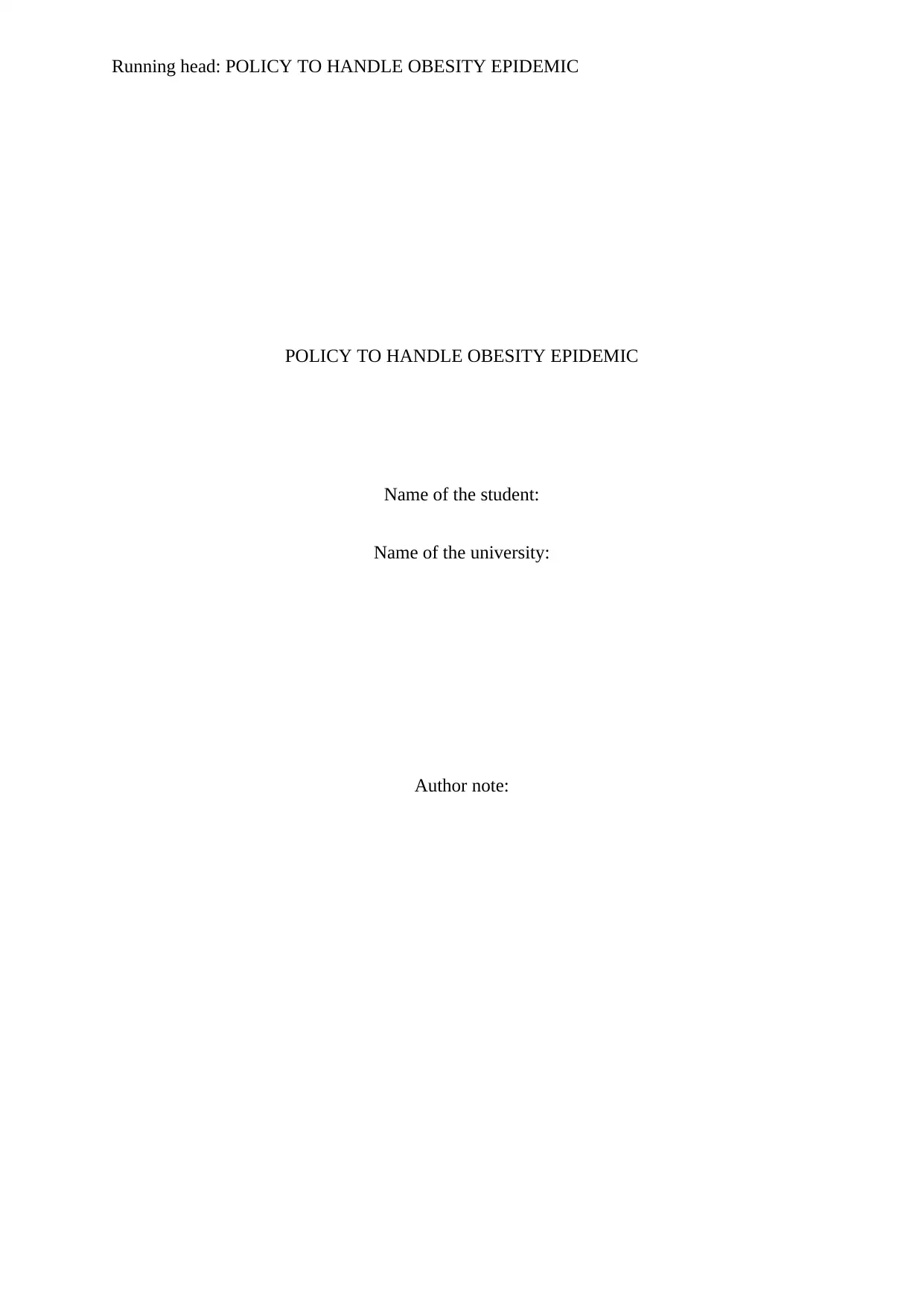
Running head: POLICY TO HANDLE OBESITY EPIDEMIC
POLICY TO HANDLE OBESITY EPIDEMIC
Name of the student:
Name of the university:
Author note:
POLICY TO HANDLE OBESITY EPIDEMIC
Name of the student:
Name of the university:
Author note:
Paraphrase This Document
Need a fresh take? Get an instant paraphrase of this document with our AI Paraphraser
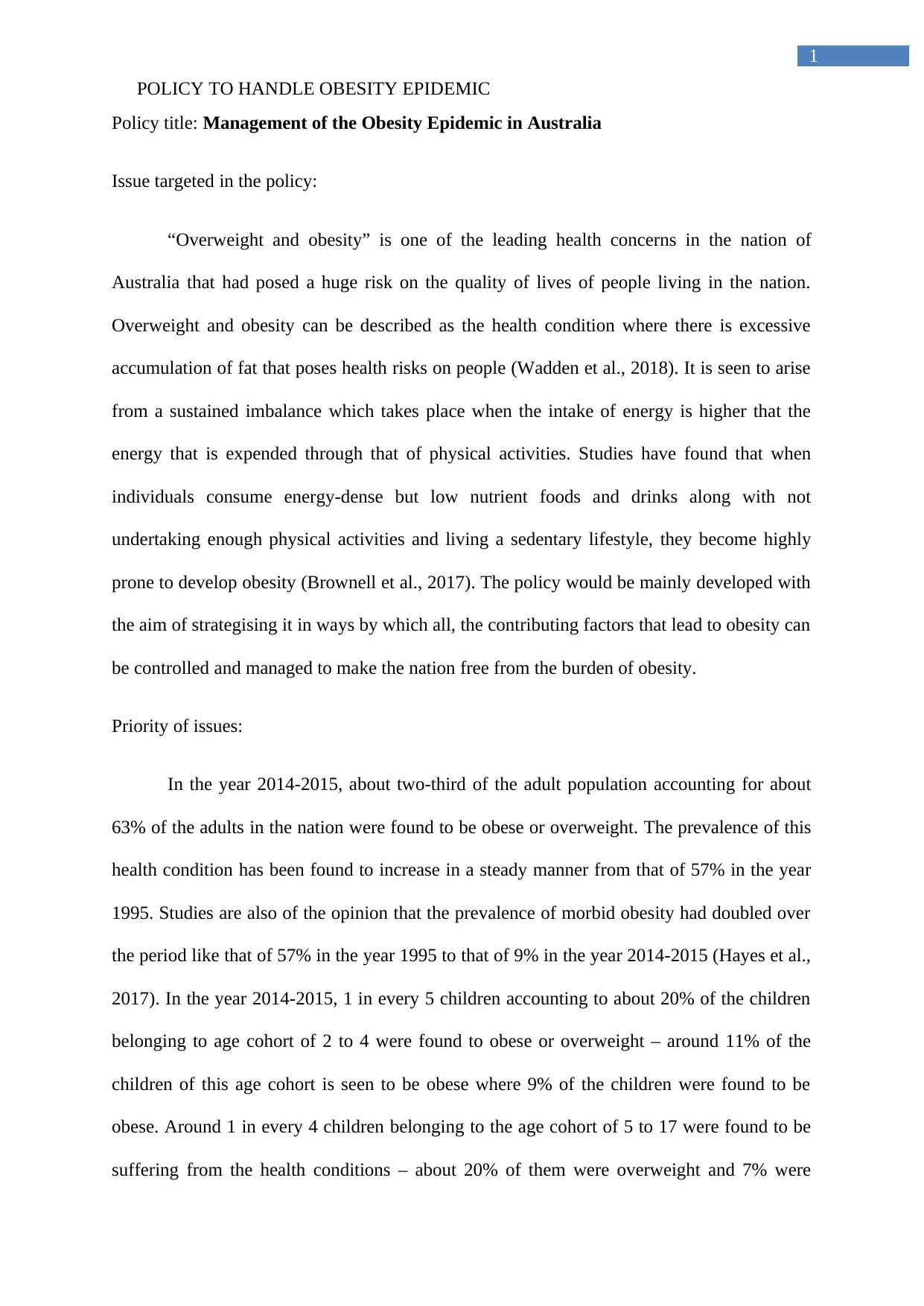
1
POLICY TO HANDLE OBESITY EPIDEMIC
Policy title: Management of the Obesity Epidemic in Australia
Issue targeted in the policy:
“Overweight and obesity” is one of the leading health concerns in the nation of
Australia that had posed a huge risk on the quality of lives of people living in the nation.
Overweight and obesity can be described as the health condition where there is excessive
accumulation of fat that poses health risks on people (Wadden et al., 2018). It is seen to arise
from a sustained imbalance which takes place when the intake of energy is higher that the
energy that is expended through that of physical activities. Studies have found that when
individuals consume energy-dense but low nutrient foods and drinks along with not
undertaking enough physical activities and living a sedentary lifestyle, they become highly
prone to develop obesity (Brownell et al., 2017). The policy would be mainly developed with
the aim of strategising it in ways by which all, the contributing factors that lead to obesity can
be controlled and managed to make the nation free from the burden of obesity.
Priority of issues:
In the year 2014-2015, about two-third of the adult population accounting for about
63% of the adults in the nation were found to be obese or overweight. The prevalence of this
health condition has been found to increase in a steady manner from that of 57% in the year
1995. Studies are also of the opinion that the prevalence of morbid obesity had doubled over
the period like that of 57% in the year 1995 to that of 9% in the year 2014-2015 (Hayes et al.,
2017). In the year 2014-2015, 1 in every 5 children accounting to about 20% of the children
belonging to age cohort of 2 to 4 were found to obese or overweight – around 11% of the
children of this age cohort is seen to be obese where 9% of the children were found to be
obese. Around 1 in every 4 children belonging to the age cohort of 5 to 17 were found to be
suffering from the health conditions – about 20% of them were overweight and 7% were
POLICY TO HANDLE OBESITY EPIDEMIC
Policy title: Management of the Obesity Epidemic in Australia
Issue targeted in the policy:
“Overweight and obesity” is one of the leading health concerns in the nation of
Australia that had posed a huge risk on the quality of lives of people living in the nation.
Overweight and obesity can be described as the health condition where there is excessive
accumulation of fat that poses health risks on people (Wadden et al., 2018). It is seen to arise
from a sustained imbalance which takes place when the intake of energy is higher that the
energy that is expended through that of physical activities. Studies have found that when
individuals consume energy-dense but low nutrient foods and drinks along with not
undertaking enough physical activities and living a sedentary lifestyle, they become highly
prone to develop obesity (Brownell et al., 2017). The policy would be mainly developed with
the aim of strategising it in ways by which all, the contributing factors that lead to obesity can
be controlled and managed to make the nation free from the burden of obesity.
Priority of issues:
In the year 2014-2015, about two-third of the adult population accounting for about
63% of the adults in the nation were found to be obese or overweight. The prevalence of this
health condition has been found to increase in a steady manner from that of 57% in the year
1995. Studies are also of the opinion that the prevalence of morbid obesity had doubled over
the period like that of 57% in the year 1995 to that of 9% in the year 2014-2015 (Hayes et al.,
2017). In the year 2014-2015, 1 in every 5 children accounting to about 20% of the children
belonging to age cohort of 2 to 4 were found to obese or overweight – around 11% of the
children of this age cohort is seen to be obese where 9% of the children were found to be
obese. Around 1 in every 4 children belonging to the age cohort of 5 to 17 were found to be
suffering from the health conditions – about 20% of them were overweight and 7% were
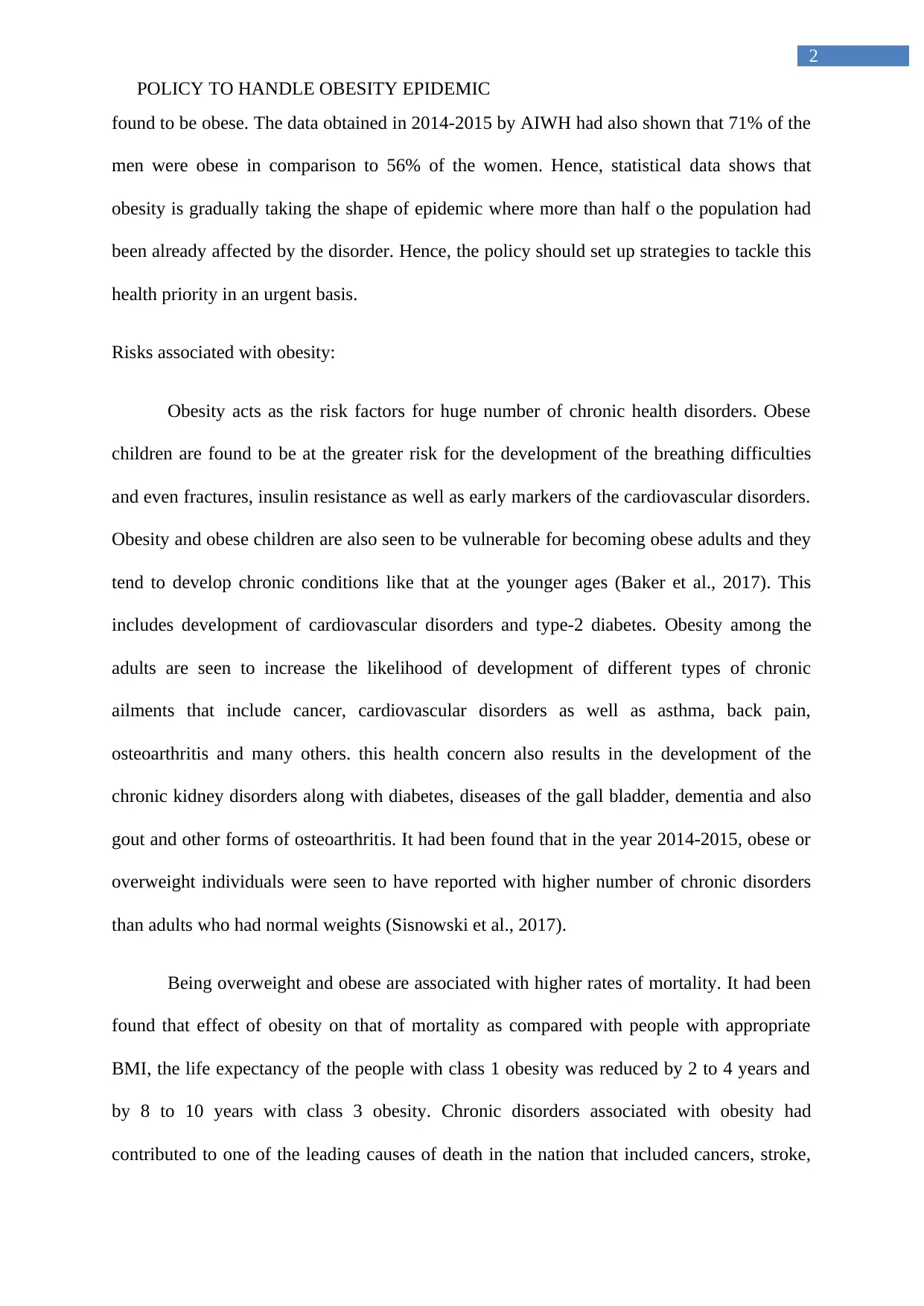
2
POLICY TO HANDLE OBESITY EPIDEMIC
found to be obese. The data obtained in 2014-2015 by AIWH had also shown that 71% of the
men were obese in comparison to 56% of the women. Hence, statistical data shows that
obesity is gradually taking the shape of epidemic where more than half o the population had
been already affected by the disorder. Hence, the policy should set up strategies to tackle this
health priority in an urgent basis.
Risks associated with obesity:
Obesity acts as the risk factors for huge number of chronic health disorders. Obese
children are found to be at the greater risk for the development of the breathing difficulties
and even fractures, insulin resistance as well as early markers of the cardiovascular disorders.
Obesity and obese children are also seen to be vulnerable for becoming obese adults and they
tend to develop chronic conditions like that at the younger ages (Baker et al., 2017). This
includes development of cardiovascular disorders and type-2 diabetes. Obesity among the
adults are seen to increase the likelihood of development of different types of chronic
ailments that include cancer, cardiovascular disorders as well as asthma, back pain,
osteoarthritis and many others. this health concern also results in the development of the
chronic kidney disorders along with diabetes, diseases of the gall bladder, dementia and also
gout and other forms of osteoarthritis. It had been found that in the year 2014-2015, obese or
overweight individuals were seen to have reported with higher number of chronic disorders
than adults who had normal weights (Sisnowski et al., 2017).
Being overweight and obese are associated with higher rates of mortality. It had been
found that effect of obesity on that of mortality as compared with people with appropriate
BMI, the life expectancy of the people with class 1 obesity was reduced by 2 to 4 years and
by 8 to 10 years with class 3 obesity. Chronic disorders associated with obesity had
contributed to one of the leading causes of death in the nation that included cancers, stroke,
POLICY TO HANDLE OBESITY EPIDEMIC
found to be obese. The data obtained in 2014-2015 by AIWH had also shown that 71% of the
men were obese in comparison to 56% of the women. Hence, statistical data shows that
obesity is gradually taking the shape of epidemic where more than half o the population had
been already affected by the disorder. Hence, the policy should set up strategies to tackle this
health priority in an urgent basis.
Risks associated with obesity:
Obesity acts as the risk factors for huge number of chronic health disorders. Obese
children are found to be at the greater risk for the development of the breathing difficulties
and even fractures, insulin resistance as well as early markers of the cardiovascular disorders.
Obesity and obese children are also seen to be vulnerable for becoming obese adults and they
tend to develop chronic conditions like that at the younger ages (Baker et al., 2017). This
includes development of cardiovascular disorders and type-2 diabetes. Obesity among the
adults are seen to increase the likelihood of development of different types of chronic
ailments that include cancer, cardiovascular disorders as well as asthma, back pain,
osteoarthritis and many others. this health concern also results in the development of the
chronic kidney disorders along with diabetes, diseases of the gall bladder, dementia and also
gout and other forms of osteoarthritis. It had been found that in the year 2014-2015, obese or
overweight individuals were seen to have reported with higher number of chronic disorders
than adults who had normal weights (Sisnowski et al., 2017).
Being overweight and obese are associated with higher rates of mortality. It had been
found that effect of obesity on that of mortality as compared with people with appropriate
BMI, the life expectancy of the people with class 1 obesity was reduced by 2 to 4 years and
by 8 to 10 years with class 3 obesity. Chronic disorders associated with obesity had
contributed to one of the leading causes of death in the nation that included cancers, stroke,
⊘ This is a preview!⊘
Do you want full access?
Subscribe today to unlock all pages.

Trusted by 1+ million students worldwide
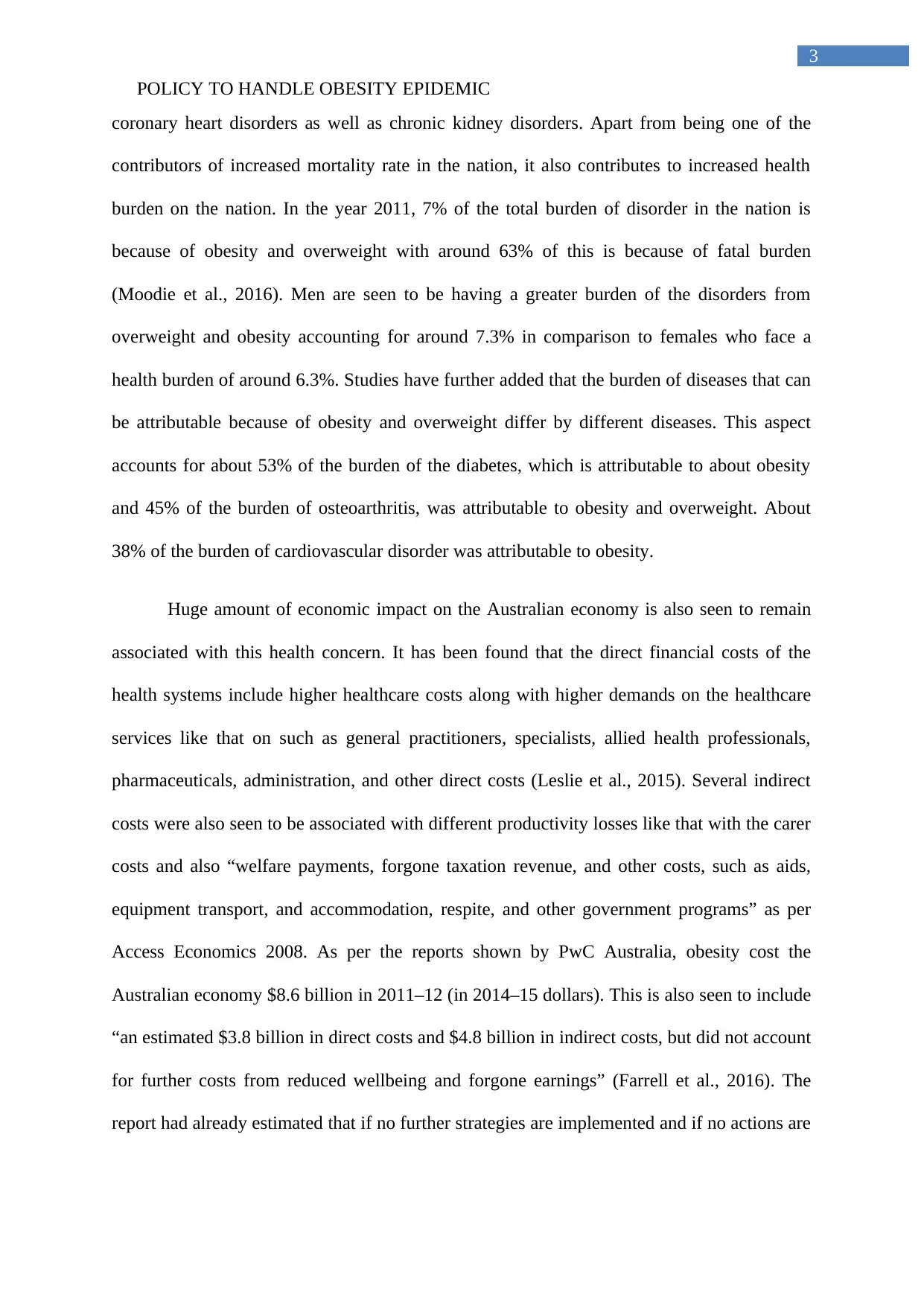
3
POLICY TO HANDLE OBESITY EPIDEMIC
coronary heart disorders as well as chronic kidney disorders. Apart from being one of the
contributors of increased mortality rate in the nation, it also contributes to increased health
burden on the nation. In the year 2011, 7% of the total burden of disorder in the nation is
because of obesity and overweight with around 63% of this is because of fatal burden
(Moodie et al., 2016). Men are seen to be having a greater burden of the disorders from
overweight and obesity accounting for around 7.3% in comparison to females who face a
health burden of around 6.3%. Studies have further added that the burden of diseases that can
be attributable because of obesity and overweight differ by different diseases. This aspect
accounts for about 53% of the burden of the diabetes, which is attributable to about obesity
and 45% of the burden of osteoarthritis, was attributable to obesity and overweight. About
38% of the burden of cardiovascular disorder was attributable to obesity.
Huge amount of economic impact on the Australian economy is also seen to remain
associated with this health concern. It has been found that the direct financial costs of the
health systems include higher healthcare costs along with higher demands on the healthcare
services like that on such as general practitioners, specialists, allied health professionals,
pharmaceuticals, administration, and other direct costs (Leslie et al., 2015). Several indirect
costs were also seen to be associated with different productivity losses like that with the carer
costs and also “welfare payments, forgone taxation revenue, and other costs, such as aids,
equipment transport, and accommodation, respite, and other government programs” as per
Access Economics 2008. As per the reports shown by PwC Australia, obesity cost the
Australian economy $8.6 billion in 2011–12 (in 2014–15 dollars). This is also seen to include
“an estimated $3.8 billion in direct costs and $4.8 billion in indirect costs, but did not account
for further costs from reduced wellbeing and forgone earnings” (Farrell et al., 2016). The
report had already estimated that if no further strategies are implemented and if no actions are
POLICY TO HANDLE OBESITY EPIDEMIC
coronary heart disorders as well as chronic kidney disorders. Apart from being one of the
contributors of increased mortality rate in the nation, it also contributes to increased health
burden on the nation. In the year 2011, 7% of the total burden of disorder in the nation is
because of obesity and overweight with around 63% of this is because of fatal burden
(Moodie et al., 2016). Men are seen to be having a greater burden of the disorders from
overweight and obesity accounting for around 7.3% in comparison to females who face a
health burden of around 6.3%. Studies have further added that the burden of diseases that can
be attributable because of obesity and overweight differ by different diseases. This aspect
accounts for about 53% of the burden of the diabetes, which is attributable to about obesity
and 45% of the burden of osteoarthritis, was attributable to obesity and overweight. About
38% of the burden of cardiovascular disorder was attributable to obesity.
Huge amount of economic impact on the Australian economy is also seen to remain
associated with this health concern. It has been found that the direct financial costs of the
health systems include higher healthcare costs along with higher demands on the healthcare
services like that on such as general practitioners, specialists, allied health professionals,
pharmaceuticals, administration, and other direct costs (Leslie et al., 2015). Several indirect
costs were also seen to be associated with different productivity losses like that with the carer
costs and also “welfare payments, forgone taxation revenue, and other costs, such as aids,
equipment transport, and accommodation, respite, and other government programs” as per
Access Economics 2008. As per the reports shown by PwC Australia, obesity cost the
Australian economy $8.6 billion in 2011–12 (in 2014–15 dollars). This is also seen to include
“an estimated $3.8 billion in direct costs and $4.8 billion in indirect costs, but did not account
for further costs from reduced wellbeing and forgone earnings” (Farrell et al., 2016). The
report had already estimated that if no further strategies are implemented and if no actions are
Paraphrase This Document
Need a fresh take? Get an instant paraphrase of this document with our AI Paraphraser
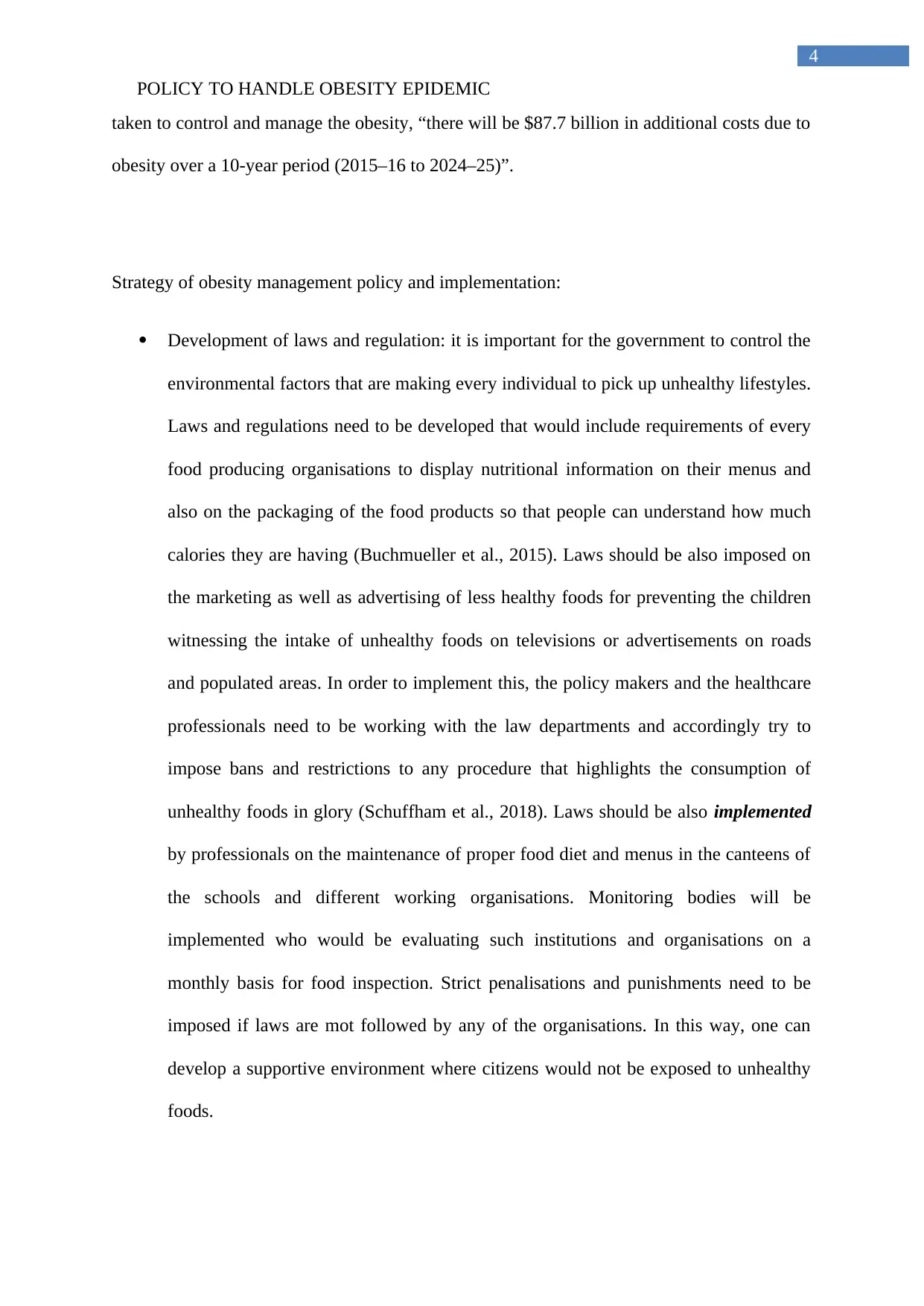
4
POLICY TO HANDLE OBESITY EPIDEMIC
taken to control and manage the obesity, “there will be $87.7 billion in additional costs due to
obesity over a 10-year period (2015–16 to 2024–25)”.
Strategy of obesity management policy and implementation:
Development of laws and regulation: it is important for the government to control the
environmental factors that are making every individual to pick up unhealthy lifestyles.
Laws and regulations need to be developed that would include requirements of every
food producing organisations to display nutritional information on their menus and
also on the packaging of the food products so that people can understand how much
calories they are having (Buchmueller et al., 2015). Laws should be also imposed on
the marketing as well as advertising of less healthy foods for preventing the children
witnessing the intake of unhealthy foods on televisions or advertisements on roads
and populated areas. In order to implement this, the policy makers and the healthcare
professionals need to be working with the law departments and accordingly try to
impose bans and restrictions to any procedure that highlights the consumption of
unhealthy foods in glory (Schuffham et al., 2018). Laws should be also implemented
by professionals on the maintenance of proper food diet and menus in the canteens of
the schools and different working organisations. Monitoring bodies will be
implemented who would be evaluating such institutions and organisations on a
monthly basis for food inspection. Strict penalisations and punishments need to be
imposed if laws are mot followed by any of the organisations. In this way, one can
develop a supportive environment where citizens would not be exposed to unhealthy
foods.
POLICY TO HANDLE OBESITY EPIDEMIC
taken to control and manage the obesity, “there will be $87.7 billion in additional costs due to
obesity over a 10-year period (2015–16 to 2024–25)”.
Strategy of obesity management policy and implementation:
Development of laws and regulation: it is important for the government to control the
environmental factors that are making every individual to pick up unhealthy lifestyles.
Laws and regulations need to be developed that would include requirements of every
food producing organisations to display nutritional information on their menus and
also on the packaging of the food products so that people can understand how much
calories they are having (Buchmueller et al., 2015). Laws should be also imposed on
the marketing as well as advertising of less healthy foods for preventing the children
witnessing the intake of unhealthy foods on televisions or advertisements on roads
and populated areas. In order to implement this, the policy makers and the healthcare
professionals need to be working with the law departments and accordingly try to
impose bans and restrictions to any procedure that highlights the consumption of
unhealthy foods in glory (Schuffham et al., 2018). Laws should be also implemented
by professionals on the maintenance of proper food diet and menus in the canteens of
the schools and different working organisations. Monitoring bodies will be
implemented who would be evaluating such institutions and organisations on a
monthly basis for food inspection. Strict penalisations and punishments need to be
imposed if laws are mot followed by any of the organisations. In this way, one can
develop a supportive environment where citizens would not be exposed to unhealthy
foods.
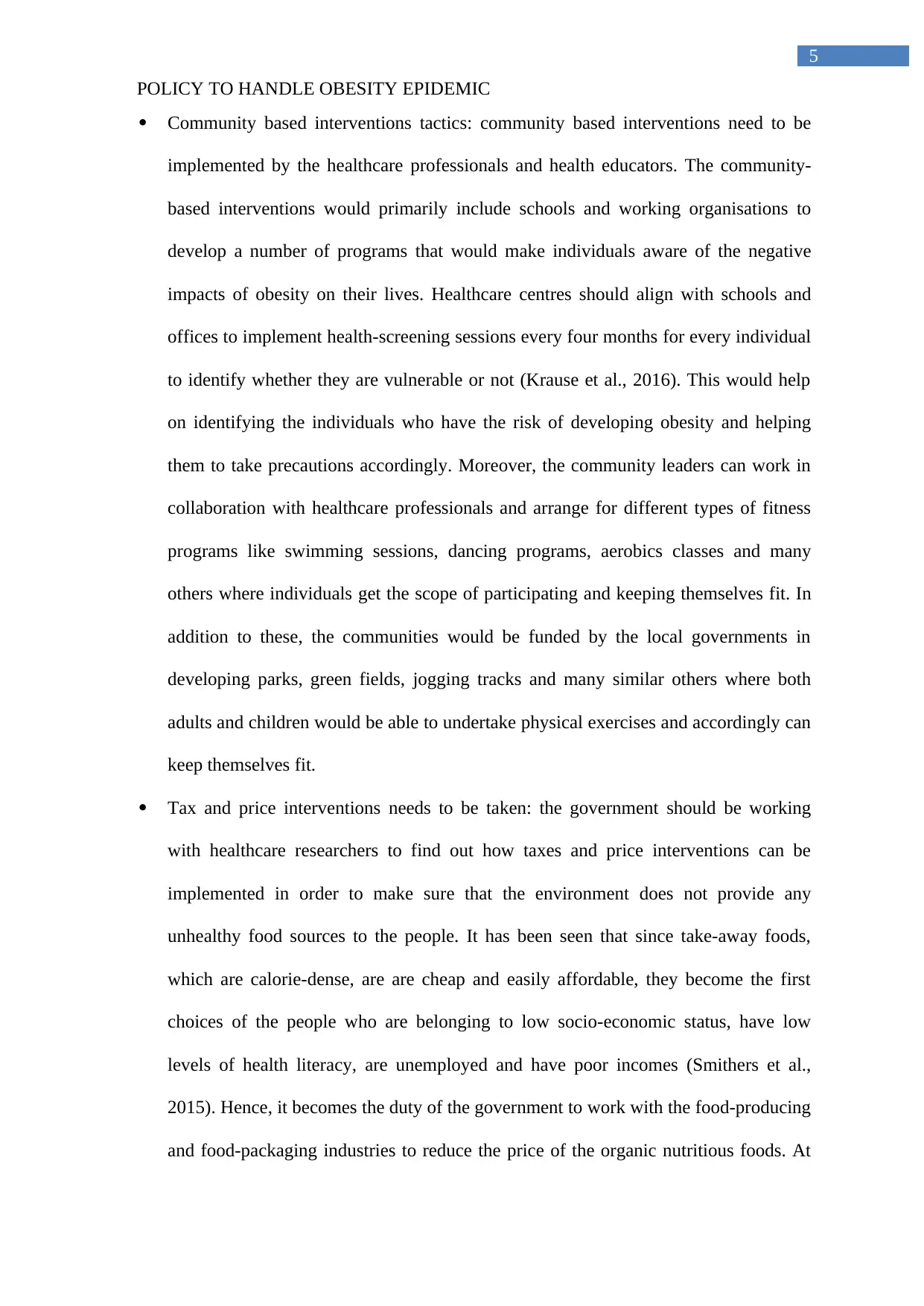
5
POLICY TO HANDLE OBESITY EPIDEMIC
Community based interventions tactics: community based interventions need to be
implemented by the healthcare professionals and health educators. The community-
based interventions would primarily include schools and working organisations to
develop a number of programs that would make individuals aware of the negative
impacts of obesity on their lives. Healthcare centres should align with schools and
offices to implement health-screening sessions every four months for every individual
to identify whether they are vulnerable or not (Krause et al., 2016). This would help
on identifying the individuals who have the risk of developing obesity and helping
them to take precautions accordingly. Moreover, the community leaders can work in
collaboration with healthcare professionals and arrange for different types of fitness
programs like swimming sessions, dancing programs, aerobics classes and many
others where individuals get the scope of participating and keeping themselves fit. In
addition to these, the communities would be funded by the local governments in
developing parks, green fields, jogging tracks and many similar others where both
adults and children would be able to undertake physical exercises and accordingly can
keep themselves fit.
Tax and price interventions needs to be taken: the government should be working
with healthcare researchers to find out how taxes and price interventions can be
implemented in order to make sure that the environment does not provide any
unhealthy food sources to the people. It has been seen that since take-away foods,
which are calorie-dense, are are cheap and easily affordable, they become the first
choices of the people who are belonging to low socio-economic status, have low
levels of health literacy, are unemployed and have poor incomes (Smithers et al.,
2015). Hence, it becomes the duty of the government to work with the food-producing
and food-packaging industries to reduce the price of the organic nutritious foods. At
POLICY TO HANDLE OBESITY EPIDEMIC
Community based interventions tactics: community based interventions need to be
implemented by the healthcare professionals and health educators. The community-
based interventions would primarily include schools and working organisations to
develop a number of programs that would make individuals aware of the negative
impacts of obesity on their lives. Healthcare centres should align with schools and
offices to implement health-screening sessions every four months for every individual
to identify whether they are vulnerable or not (Krause et al., 2016). This would help
on identifying the individuals who have the risk of developing obesity and helping
them to take precautions accordingly. Moreover, the community leaders can work in
collaboration with healthcare professionals and arrange for different types of fitness
programs like swimming sessions, dancing programs, aerobics classes and many
others where individuals get the scope of participating and keeping themselves fit. In
addition to these, the communities would be funded by the local governments in
developing parks, green fields, jogging tracks and many similar others where both
adults and children would be able to undertake physical exercises and accordingly can
keep themselves fit.
Tax and price interventions needs to be taken: the government should be working
with healthcare researchers to find out how taxes and price interventions can be
implemented in order to make sure that the environment does not provide any
unhealthy food sources to the people. It has been seen that since take-away foods,
which are calorie-dense, are are cheap and easily affordable, they become the first
choices of the people who are belonging to low socio-economic status, have low
levels of health literacy, are unemployed and have poor incomes (Smithers et al.,
2015). Hence, it becomes the duty of the government to work with the food-producing
and food-packaging industries to reduce the price of the organic nutritious foods. At
⊘ This is a preview!⊘
Do you want full access?
Subscribe today to unlock all pages.

Trusted by 1+ million students worldwide
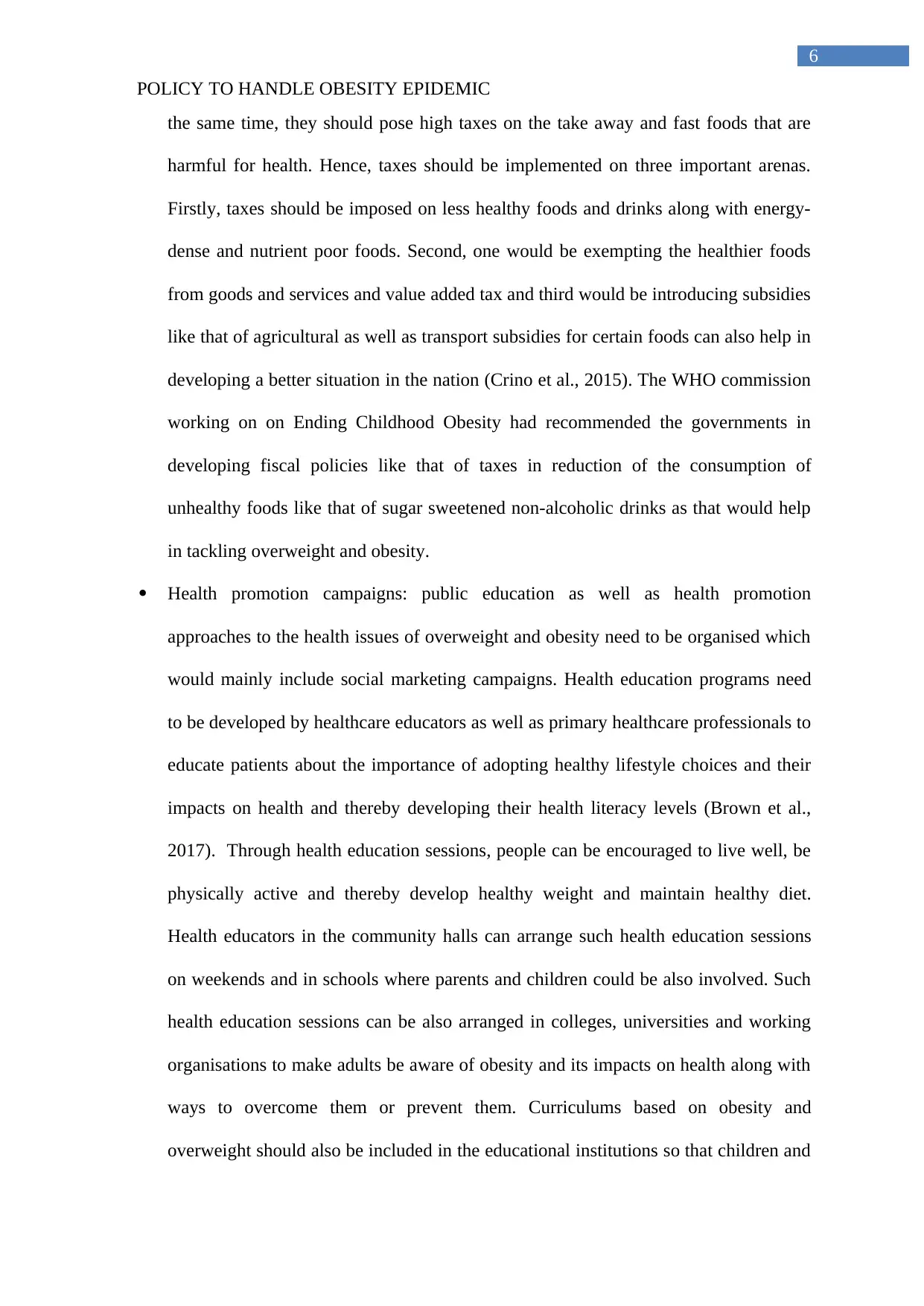
6
POLICY TO HANDLE OBESITY EPIDEMIC
the same time, they should pose high taxes on the take away and fast foods that are
harmful for health. Hence, taxes should be implemented on three important arenas.
Firstly, taxes should be imposed on less healthy foods and drinks along with energy-
dense and nutrient poor foods. Second, one would be exempting the healthier foods
from goods and services and value added tax and third would be introducing subsidies
like that of agricultural as well as transport subsidies for certain foods can also help in
developing a better situation in the nation (Crino et al., 2015). The WHO commission
working on on Ending Childhood Obesity had recommended the governments in
developing fiscal policies like that of taxes in reduction of the consumption of
unhealthy foods like that of sugar sweetened non-alcoholic drinks as that would help
in tackling overweight and obesity.
Health promotion campaigns: public education as well as health promotion
approaches to the health issues of overweight and obesity need to be organised which
would mainly include social marketing campaigns. Health education programs need
to be developed by healthcare educators as well as primary healthcare professionals to
educate patients about the importance of adopting healthy lifestyle choices and their
impacts on health and thereby developing their health literacy levels (Brown et al.,
2017). Through health education sessions, people can be encouraged to live well, be
physically active and thereby develop healthy weight and maintain healthy diet.
Health educators in the community halls can arrange such health education sessions
on weekends and in schools where parents and children could be also involved. Such
health education sessions can be also arranged in colleges, universities and working
organisations to make adults be aware of obesity and its impacts on health along with
ways to overcome them or prevent them. Curriculums based on obesity and
overweight should also be included in the educational institutions so that children and
POLICY TO HANDLE OBESITY EPIDEMIC
the same time, they should pose high taxes on the take away and fast foods that are
harmful for health. Hence, taxes should be implemented on three important arenas.
Firstly, taxes should be imposed on less healthy foods and drinks along with energy-
dense and nutrient poor foods. Second, one would be exempting the healthier foods
from goods and services and value added tax and third would be introducing subsidies
like that of agricultural as well as transport subsidies for certain foods can also help in
developing a better situation in the nation (Crino et al., 2015). The WHO commission
working on on Ending Childhood Obesity had recommended the governments in
developing fiscal policies like that of taxes in reduction of the consumption of
unhealthy foods like that of sugar sweetened non-alcoholic drinks as that would help
in tackling overweight and obesity.
Health promotion campaigns: public education as well as health promotion
approaches to the health issues of overweight and obesity need to be organised which
would mainly include social marketing campaigns. Health education programs need
to be developed by healthcare educators as well as primary healthcare professionals to
educate patients about the importance of adopting healthy lifestyle choices and their
impacts on health and thereby developing their health literacy levels (Brown et al.,
2017). Through health education sessions, people can be encouraged to live well, be
physically active and thereby develop healthy weight and maintain healthy diet.
Health educators in the community halls can arrange such health education sessions
on weekends and in schools where parents and children could be also involved. Such
health education sessions can be also arranged in colleges, universities and working
organisations to make adults be aware of obesity and its impacts on health along with
ways to overcome them or prevent them. Curriculums based on obesity and
overweight should also be included in the educational institutions so that children and
Paraphrase This Document
Need a fresh take? Get an instant paraphrase of this document with our AI Paraphraser
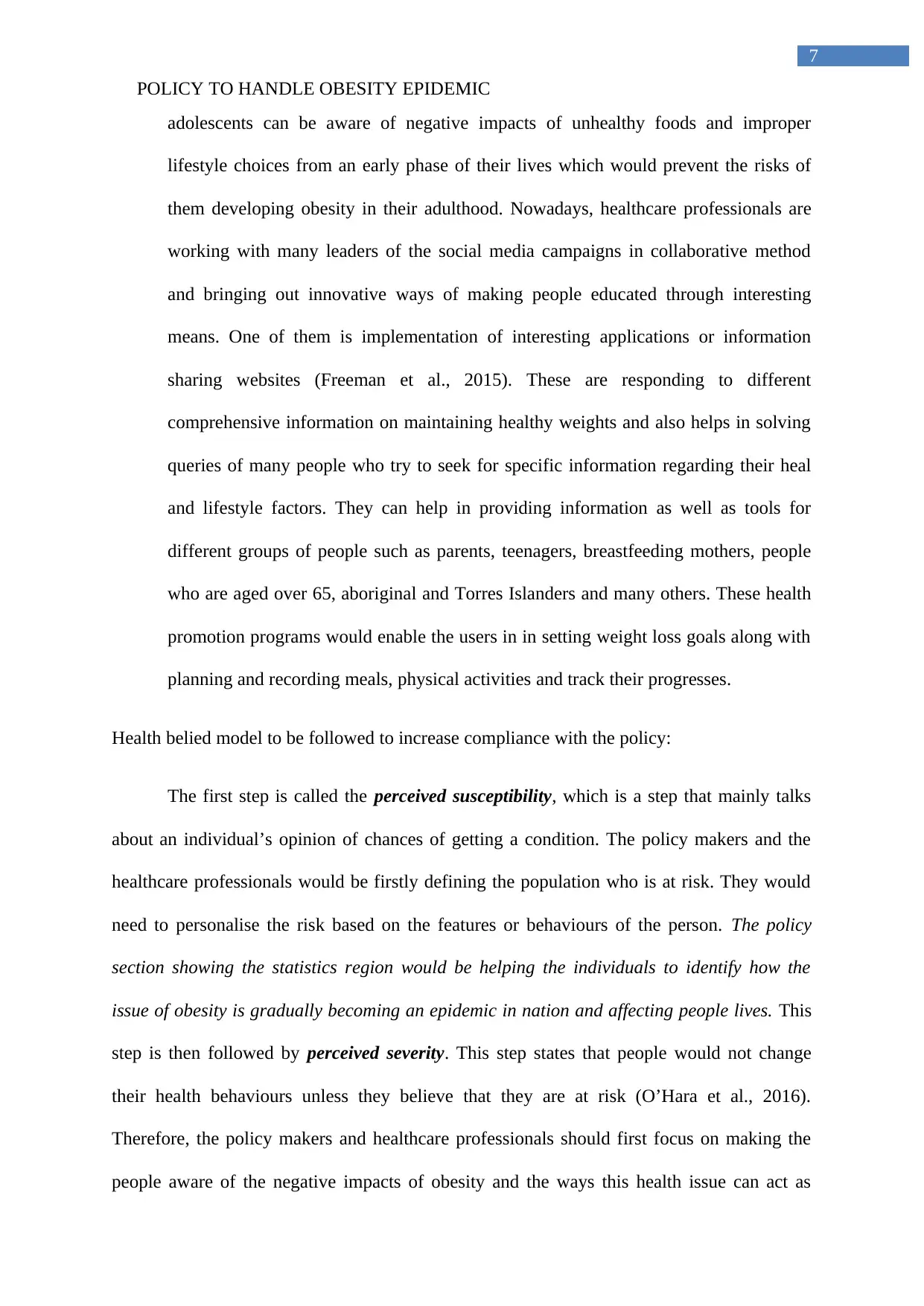
7
POLICY TO HANDLE OBESITY EPIDEMIC
adolescents can be aware of negative impacts of unhealthy foods and improper
lifestyle choices from an early phase of their lives which would prevent the risks of
them developing obesity in their adulthood. Nowadays, healthcare professionals are
working with many leaders of the social media campaigns in collaborative method
and bringing out innovative ways of making people educated through interesting
means. One of them is implementation of interesting applications or information
sharing websites (Freeman et al., 2015). These are responding to different
comprehensive information on maintaining healthy weights and also helps in solving
queries of many people who try to seek for specific information regarding their heal
and lifestyle factors. They can help in providing information as well as tools for
different groups of people such as parents, teenagers, breastfeeding mothers, people
who are aged over 65, aboriginal and Torres Islanders and many others. These health
promotion programs would enable the users in in setting weight loss goals along with
planning and recording meals, physical activities and track their progresses.
Health belied model to be followed to increase compliance with the policy:
The first step is called the perceived susceptibility, which is a step that mainly talks
about an individual’s opinion of chances of getting a condition. The policy makers and the
healthcare professionals would be firstly defining the population who is at risk. They would
need to personalise the risk based on the features or behaviours of the person. The policy
section showing the statistics region would be helping the individuals to identify how the
issue of obesity is gradually becoming an epidemic in nation and affecting people lives. This
step is then followed by perceived severity. This step states that people would not change
their health behaviours unless they believe that they are at risk (O’Hara et al., 2016).
Therefore, the policy makers and healthcare professionals should first focus on making the
people aware of the negative impacts of obesity and the ways this health issue can act as
POLICY TO HANDLE OBESITY EPIDEMIC
adolescents can be aware of negative impacts of unhealthy foods and improper
lifestyle choices from an early phase of their lives which would prevent the risks of
them developing obesity in their adulthood. Nowadays, healthcare professionals are
working with many leaders of the social media campaigns in collaborative method
and bringing out innovative ways of making people educated through interesting
means. One of them is implementation of interesting applications or information
sharing websites (Freeman et al., 2015). These are responding to different
comprehensive information on maintaining healthy weights and also helps in solving
queries of many people who try to seek for specific information regarding their heal
and lifestyle factors. They can help in providing information as well as tools for
different groups of people such as parents, teenagers, breastfeeding mothers, people
who are aged over 65, aboriginal and Torres Islanders and many others. These health
promotion programs would enable the users in in setting weight loss goals along with
planning and recording meals, physical activities and track their progresses.
Health belied model to be followed to increase compliance with the policy:
The first step is called the perceived susceptibility, which is a step that mainly talks
about an individual’s opinion of chances of getting a condition. The policy makers and the
healthcare professionals would be firstly defining the population who is at risk. They would
need to personalise the risk based on the features or behaviours of the person. The policy
section showing the statistics region would be helping the individuals to identify how the
issue of obesity is gradually becoming an epidemic in nation and affecting people lives. This
step is then followed by perceived severity. This step states that people would not change
their health behaviours unless they believe that they are at risk (O’Hara et al., 2016).
Therefore, the policy makers and healthcare professionals should first focus on making the
people aware of the negative impacts of obesity and the ways this health issue can act as
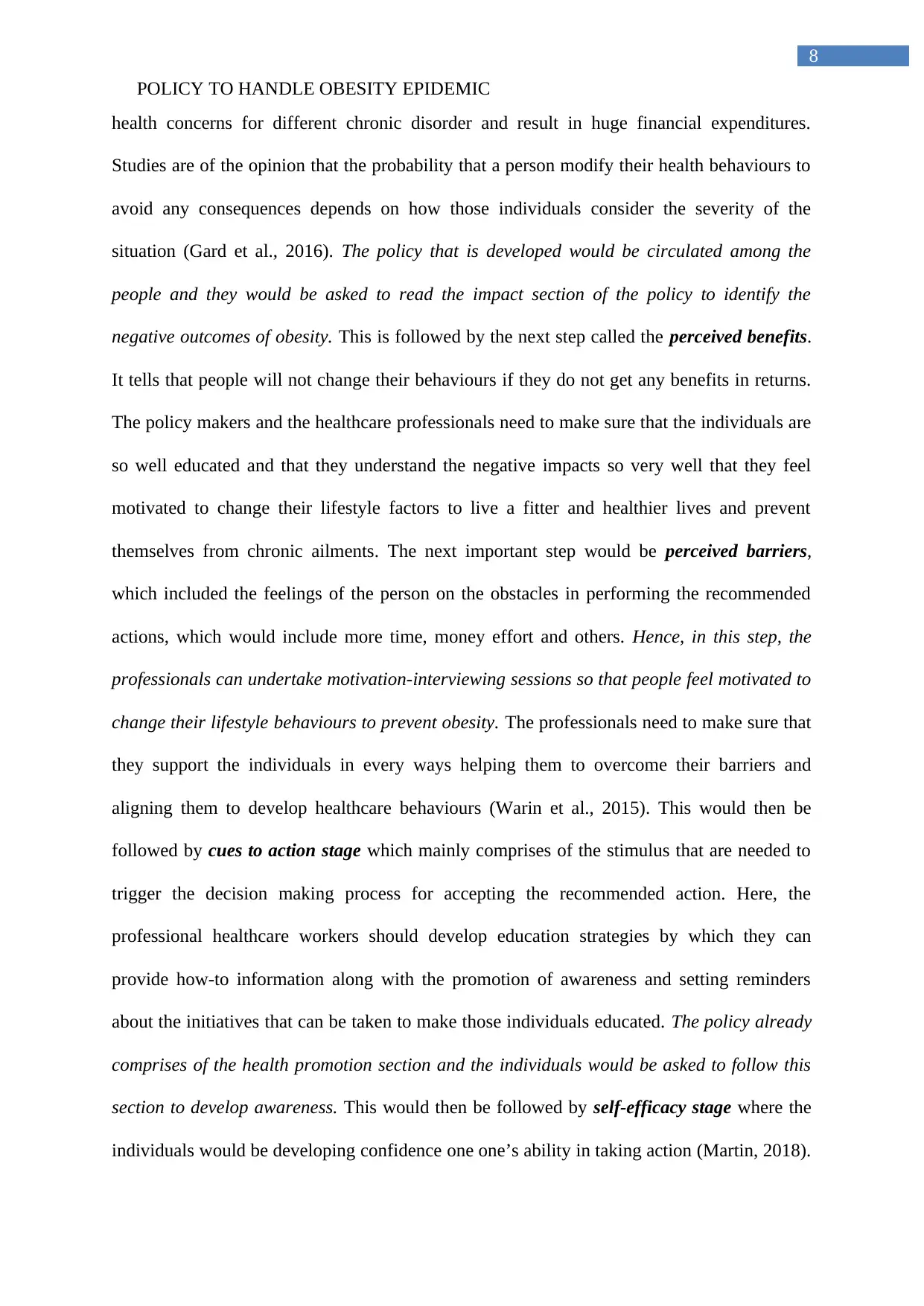
8
POLICY TO HANDLE OBESITY EPIDEMIC
health concerns for different chronic disorder and result in huge financial expenditures.
Studies are of the opinion that the probability that a person modify their health behaviours to
avoid any consequences depends on how those individuals consider the severity of the
situation (Gard et al., 2016). The policy that is developed would be circulated among the
people and they would be asked to read the impact section of the policy to identify the
negative outcomes of obesity. This is followed by the next step called the perceived benefits.
It tells that people will not change their behaviours if they do not get any benefits in returns.
The policy makers and the healthcare professionals need to make sure that the individuals are
so well educated and that they understand the negative impacts so very well that they feel
motivated to change their lifestyle factors to live a fitter and healthier lives and prevent
themselves from chronic ailments. The next important step would be perceived barriers,
which included the feelings of the person on the obstacles in performing the recommended
actions, which would include more time, money effort and others. Hence, in this step, the
professionals can undertake motivation-interviewing sessions so that people feel motivated to
change their lifestyle behaviours to prevent obesity. The professionals need to make sure that
they support the individuals in every ways helping them to overcome their barriers and
aligning them to develop healthcare behaviours (Warin et al., 2015). This would then be
followed by cues to action stage which mainly comprises of the stimulus that are needed to
trigger the decision making process for accepting the recommended action. Here, the
professional healthcare workers should develop education strategies by which they can
provide how-to information along with the promotion of awareness and setting reminders
about the initiatives that can be taken to make those individuals educated. The policy already
comprises of the health promotion section and the individuals would be asked to follow this
section to develop awareness. This would then be followed by self-efficacy stage where the
individuals would be developing confidence one one’s ability in taking action (Martin, 2018).
POLICY TO HANDLE OBESITY EPIDEMIC
health concerns for different chronic disorder and result in huge financial expenditures.
Studies are of the opinion that the probability that a person modify their health behaviours to
avoid any consequences depends on how those individuals consider the severity of the
situation (Gard et al., 2016). The policy that is developed would be circulated among the
people and they would be asked to read the impact section of the policy to identify the
negative outcomes of obesity. This is followed by the next step called the perceived benefits.
It tells that people will not change their behaviours if they do not get any benefits in returns.
The policy makers and the healthcare professionals need to make sure that the individuals are
so well educated and that they understand the negative impacts so very well that they feel
motivated to change their lifestyle factors to live a fitter and healthier lives and prevent
themselves from chronic ailments. The next important step would be perceived barriers,
which included the feelings of the person on the obstacles in performing the recommended
actions, which would include more time, money effort and others. Hence, in this step, the
professionals can undertake motivation-interviewing sessions so that people feel motivated to
change their lifestyle behaviours to prevent obesity. The professionals need to make sure that
they support the individuals in every ways helping them to overcome their barriers and
aligning them to develop healthcare behaviours (Warin et al., 2015). This would then be
followed by cues to action stage which mainly comprises of the stimulus that are needed to
trigger the decision making process for accepting the recommended action. Here, the
professional healthcare workers should develop education strategies by which they can
provide how-to information along with the promotion of awareness and setting reminders
about the initiatives that can be taken to make those individuals educated. The policy already
comprises of the health promotion section and the individuals would be asked to follow this
section to develop awareness. This would then be followed by self-efficacy stage where the
individuals would be developing confidence one one’s ability in taking action (Martin, 2018).
⊘ This is a preview!⊘
Do you want full access?
Subscribe today to unlock all pages.

Trusted by 1+ million students worldwide

9
POLICY TO HANDLE OBESITY EPIDEMIC
The professionals should ensure providing training to the patients along with guidance and
helping them to perform the action. In this way, with the help of the health believe model and
adopting correct strategies in the policy, the national citizens can he helped in adopting
proper lifestyle interventions, health behaviours and diets that can help them prevent
occurrence of obesity and live fitter lives in the future through following the policy in details.
POLICY TO HANDLE OBESITY EPIDEMIC
The professionals should ensure providing training to the patients along with guidance and
helping them to perform the action. In this way, with the help of the health believe model and
adopting correct strategies in the policy, the national citizens can he helped in adopting
proper lifestyle interventions, health behaviours and diets that can help them prevent
occurrence of obesity and live fitter lives in the future through following the policy in details.
Paraphrase This Document
Need a fresh take? Get an instant paraphrase of this document with our AI Paraphraser
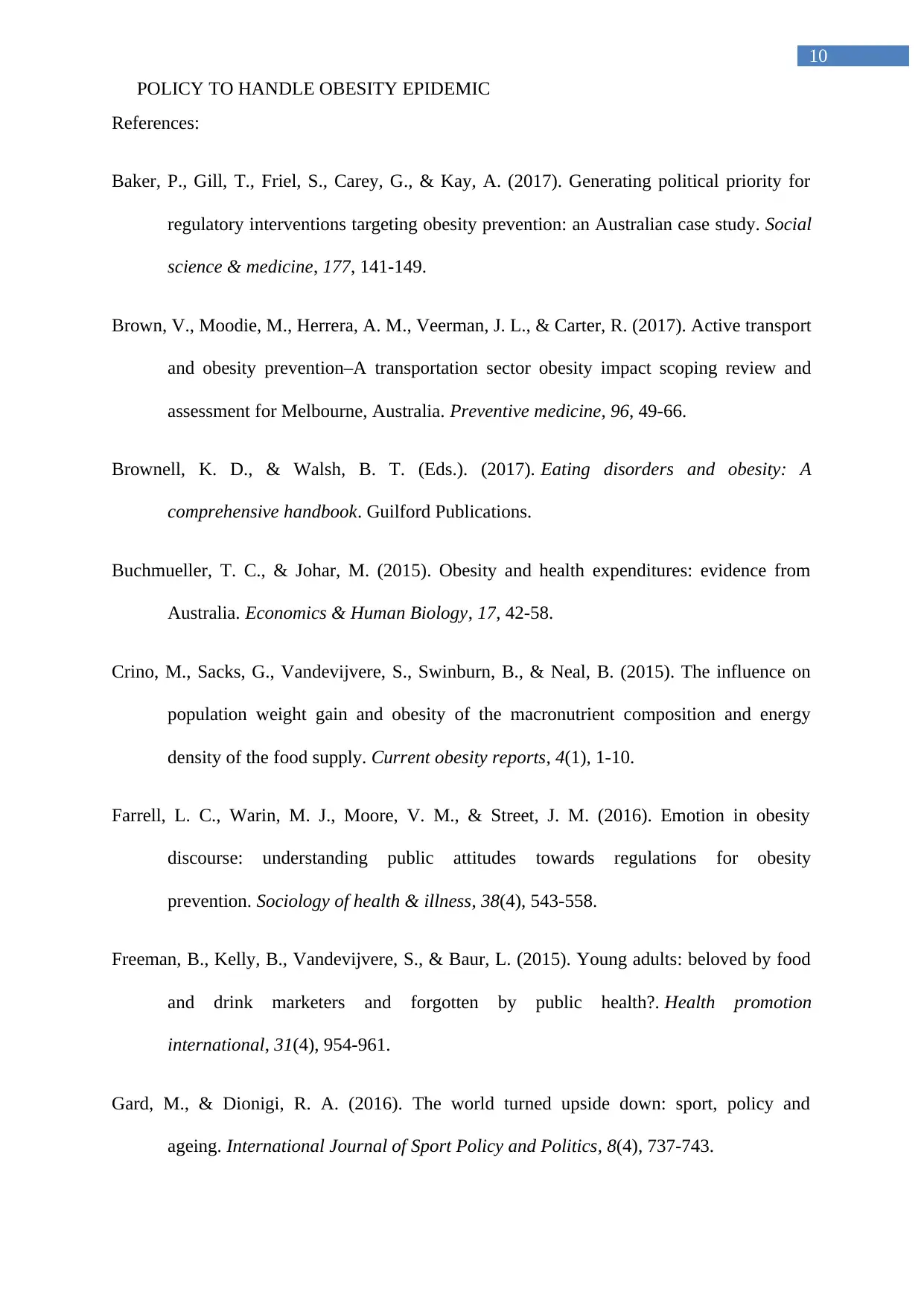
10
POLICY TO HANDLE OBESITY EPIDEMIC
References:
Baker, P., Gill, T., Friel, S., Carey, G., & Kay, A. (2017). Generating political priority for
regulatory interventions targeting obesity prevention: an Australian case study. Social
science & medicine, 177, 141-149.
Brown, V., Moodie, M., Herrera, A. M., Veerman, J. L., & Carter, R. (2017). Active transport
and obesity prevention–A transportation sector obesity impact scoping review and
assessment for Melbourne, Australia. Preventive medicine, 96, 49-66.
Brownell, K. D., & Walsh, B. T. (Eds.). (2017). Eating disorders and obesity: A
comprehensive handbook. Guilford Publications.
Buchmueller, T. C., & Johar, M. (2015). Obesity and health expenditures: evidence from
Australia. Economics & Human Biology, 17, 42-58.
Crino, M., Sacks, G., Vandevijvere, S., Swinburn, B., & Neal, B. (2015). The influence on
population weight gain and obesity of the macronutrient composition and energy
density of the food supply. Current obesity reports, 4(1), 1-10.
Farrell, L. C., Warin, M. J., Moore, V. M., & Street, J. M. (2016). Emotion in obesity
discourse: understanding public attitudes towards regulations for obesity
prevention. Sociology of health & illness, 38(4), 543-558.
Freeman, B., Kelly, B., Vandevijvere, S., & Baur, L. (2015). Young adults: beloved by food
and drink marketers and forgotten by public health?. Health promotion
international, 31(4), 954-961.
Gard, M., & Dionigi, R. A. (2016). The world turned upside down: sport, policy and
ageing. International Journal of Sport Policy and Politics, 8(4), 737-743.
POLICY TO HANDLE OBESITY EPIDEMIC
References:
Baker, P., Gill, T., Friel, S., Carey, G., & Kay, A. (2017). Generating political priority for
regulatory interventions targeting obesity prevention: an Australian case study. Social
science & medicine, 177, 141-149.
Brown, V., Moodie, M., Herrera, A. M., Veerman, J. L., & Carter, R. (2017). Active transport
and obesity prevention–A transportation sector obesity impact scoping review and
assessment for Melbourne, Australia. Preventive medicine, 96, 49-66.
Brownell, K. D., & Walsh, B. T. (Eds.). (2017). Eating disorders and obesity: A
comprehensive handbook. Guilford Publications.
Buchmueller, T. C., & Johar, M. (2015). Obesity and health expenditures: evidence from
Australia. Economics & Human Biology, 17, 42-58.
Crino, M., Sacks, G., Vandevijvere, S., Swinburn, B., & Neal, B. (2015). The influence on
population weight gain and obesity of the macronutrient composition and energy
density of the food supply. Current obesity reports, 4(1), 1-10.
Farrell, L. C., Warin, M. J., Moore, V. M., & Street, J. M. (2016). Emotion in obesity
discourse: understanding public attitudes towards regulations for obesity
prevention. Sociology of health & illness, 38(4), 543-558.
Freeman, B., Kelly, B., Vandevijvere, S., & Baur, L. (2015). Young adults: beloved by food
and drink marketers and forgotten by public health?. Health promotion
international, 31(4), 954-961.
Gard, M., & Dionigi, R. A. (2016). The world turned upside down: sport, policy and
ageing. International Journal of Sport Policy and Politics, 8(4), 737-743.

11
POLICY TO HANDLE OBESITY EPIDEMIC
Hayes, A. J., Lung, T. W. C., Bauman, A., & Howard, K. (2017). Modelling obesity trends in
Australia: unravelling the past and predicting the future. International journal of
obesity, 41(1), 178.
Krause, S., Ware, R., McPherson, L., Lennox, N., & O’Callaghan, M. (2016). Obesity in
adolescents with intellectual disability: Prevalence and associated
characteristics. Obesity research & clinical practice, 10(5), 520-530.
Leslie, E., Magarey, A., Olds, T., Ratcliffe, J., Jones, M., & Cobiac, L. (2015). Community-
based obesity prevention in Australia: Background, methods and recruitment
outcomes for the evaluation of the effectiveness of OPAL (Obesity Prevention and
Lifestyle). Advances in Pediatric Research, 2(3), 1-16.
Martin, J. (2018). Effective strategies to prevent obesity. Health Promotion Journal of
Australia, 29(S1), 26-28.
Moodie, A. R., Tolhurst, P., & Martin, J. E. (2016). Australia's health: being accountable for
prevention. Medical Journal of Australia, 204(6), 223-225.
O’Hara, L., Taylor, J., & Barnes, M. (2016). The extent to which the public health ‘war on
obesity’reflects the ethical values and principles of critical health promotion: a
multimedia critical discourse analysis. Health Promotion Journal of Australia, 26(3),
246-254.
Scuffham, P. A., Krinks, R., Chaulkidou, K., Littlejohns, P., Whitty, J. A., Wilson, A., ... &
Kendall, E. (2018). Recommendations from two citizens’ juries on the surgical
management of obesity. Obesity surgery, 28(6), 1745-1752.
POLICY TO HANDLE OBESITY EPIDEMIC
Hayes, A. J., Lung, T. W. C., Bauman, A., & Howard, K. (2017). Modelling obesity trends in
Australia: unravelling the past and predicting the future. International journal of
obesity, 41(1), 178.
Krause, S., Ware, R., McPherson, L., Lennox, N., & O’Callaghan, M. (2016). Obesity in
adolescents with intellectual disability: Prevalence and associated
characteristics. Obesity research & clinical practice, 10(5), 520-530.
Leslie, E., Magarey, A., Olds, T., Ratcliffe, J., Jones, M., & Cobiac, L. (2015). Community-
based obesity prevention in Australia: Background, methods and recruitment
outcomes for the evaluation of the effectiveness of OPAL (Obesity Prevention and
Lifestyle). Advances in Pediatric Research, 2(3), 1-16.
Martin, J. (2018). Effective strategies to prevent obesity. Health Promotion Journal of
Australia, 29(S1), 26-28.
Moodie, A. R., Tolhurst, P., & Martin, J. E. (2016). Australia's health: being accountable for
prevention. Medical Journal of Australia, 204(6), 223-225.
O’Hara, L., Taylor, J., & Barnes, M. (2016). The extent to which the public health ‘war on
obesity’reflects the ethical values and principles of critical health promotion: a
multimedia critical discourse analysis. Health Promotion Journal of Australia, 26(3),
246-254.
Scuffham, P. A., Krinks, R., Chaulkidou, K., Littlejohns, P., Whitty, J. A., Wilson, A., ... &
Kendall, E. (2018). Recommendations from two citizens’ juries on the surgical
management of obesity. Obesity surgery, 28(6), 1745-1752.
⊘ This is a preview!⊘
Do you want full access?
Subscribe today to unlock all pages.

Trusted by 1+ million students worldwide
1 out of 13
Related Documents
Your All-in-One AI-Powered Toolkit for Academic Success.
+13062052269
info@desklib.com
Available 24*7 on WhatsApp / Email
![[object Object]](/_next/static/media/star-bottom.7253800d.svg)
Unlock your academic potential
Copyright © 2020–2025 A2Z Services. All Rights Reserved. Developed and managed by ZUCOL.





